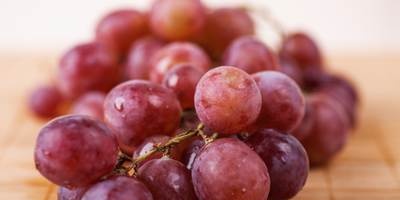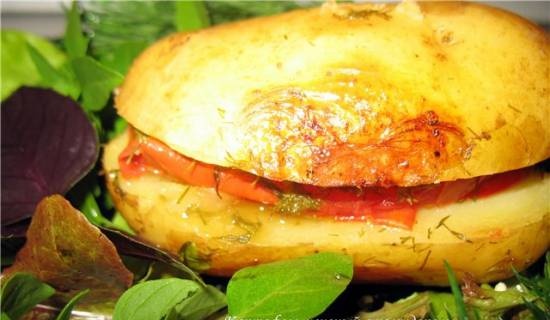|
 One of the main and valuable biological properties of grapes is the ability to use solar energy in the most efficient way. As a result, the sugar content in ripe berries is very high - it reaches 30-35%, and even more during withering. Dried grapes, raisins and raisins contain 60-70% sugar. One of the main and valuable biological properties of grapes is the ability to use solar energy in the most efficient way. As a result, the sugar content in ripe berries is very high - it reaches 30-35%, and even more during withering. Dried grapes, raisins and raisins contain 60-70% sugar.
No other plant has such a high sugar content in fruits or berries, and even in beets (which are considered to be sugar beets).
The enormous human interest in grapes is not accidental. Grape berries are a very valuable food product. This is confirmed by the fact that a person, when eating 1 kg of fresh grapes, receives only 200 g of sugar, which is equal to 1000 calories of thermal energy. This is more than 1 kg of milk or potatoes gives off.
The use of fresh grapes is especially important for the strengthening and development of all organs of the human body.
The sugar contained in grapes is presented in the form of monosaccharides easily assimilated by the body - glucose and fructose in equal amounts.
The grape also has great medicinal properties.
When grapes and products of its processing are consumed, in addition to easily digestible sugars, acids are also supplied to the human body, which have a bactericidal effect, in this regard, the body's resistance to various diseases increases.
Physiologists say that tartaric acid, which is extremely necessary for humans, is found only in the juice of grape berries.
 Grape juice is a product of non-alcoholic processing of grapes. It contains vitamins, sugar (in the form of glucose and fructose), organic acids and other substances. When drinking grape juice, appetite improves, metabolism increases, and digestion improves. Grape juice is a product of non-alcoholic processing of grapes. It contains vitamins, sugar (in the form of glucose and fructose), organic acids and other substances. When drinking grape juice, appetite improves, metabolism increases, and digestion improves.
Grapes and juices from it contribute to the rapid recovery of expended energy.
It has been established that in areas where grape juice, fresh and dried grapes are regularly consumed, children almost never experience diseases such as rickets, anemia, etc.
The systematic use of fresh grapes gives positive results in the treatment of pulmonary tuberculosis, various diseases of the stomach, heart and kidneys.
Some rules must be followed when eating fresh grapes and grape juice.
Their use should be started with small doses - 250-300 g of grapes and 200-250 cubic meters. cm of grape juice, gradually increasing over the course of a month to a maximum daily rate of 2 kg of grapes and 1 liter of grape juice. From 500 g of fresh grapes, as a rule, you can get 300-350 cubic meters. see pure grape juice.
However, in maximum doses, juice and fresh grapes can be consumed for a short time, and then it is necessary to gradually reduce them to the original rate. This allows the body to become accustomed to the beneficial, regular consumption of fresh grapes and juice.
The daily norm of berries and grape juice should not be taken in one meal as a whole, but evenly distributed throughout the day, and before meals, for example, at this time:
1) in the morning on an empty stomach, before breakfast;
2) 1-2 hours before lunch;
3) 2 hours after lunch;
4) 1-2 hours before dinner.
It is good to take a walk after eating grapes or juice - this helps to whet your appetite.
Grape juice in the summer is pleasant to drink chilled, for which 1-2 hours before drinking it can be placed in cold water together with a bottle.
Before eating fresh grapes, it must be rinsed well with water.
Wine is also used for medicinal purposes.So, for example, in the fight against malaria, cinchona preparations are more effective in a mixture with wine, which helps the production of hydrochloric acid with insufficient acidity.
Wine is sometimes successfully used for influenza-bronchial and pulmonary diseases, especially in people who have previously consumed alcoholic beverages.
Sometimes wine in small doses is useful for convalescents who have undergone serious operations; it is used as a strengthening and tonic agent in the preoperative and postoperative periods.
Grape wine is found in some medicines. On the one hand, it enhances the pharmacological action, on the other hand, it improves the taste of unpleasant drugs.
There are many old recipes for medical wines. Some of them have not lost their importance in our time. New ones are also possible, for example, fortified wines and others.
Here is what Professor NF Golubev says about the medicinal properties of wine: "There can hardly be any doubt that wine, given to the patient in due time and in proper form, is a medicinal factor of high importance."
Of course, only a doctor can prescribe wine for medicinal purposes.
Grape wine is a very valuable nutritional element; when consumed in moderation, it plays a positive role in the human diet.
Wine is valued from a dietary, therapeutic and hygienic point of view. Doctor of Biological Sciences, Professor NN Prostoserdov said on this occasion: "Grape wine in terms of its composition, easy digestibility and physiological properties is a useful drink from a dietary point of view." The opinion of L. Pasteur, who considered wine "the most hygienic of all drinks ..." is very reasonable.
Grape wine contains valuable food products: sugar in the form of glucose and fructose, organic acids - tartaric, malic, succinic, lactic, etc.: various minerals - calcium, potassium, phosphorus, magnesium, iron, etc .; trace elements - boron, iodine, manganese, molybdenum, etc .; various enzymes - invertase, pectase, protease, tannins, glycerin, vitamins - Bx, Br, B6, C.
Ethyl alcohol in concentrated form has a strong and harmful effect on the human body.
Alcohol is perceived in a completely different way by the human body if it is introduced into it in small and, moreover, diluted doses, as is observed when drinking table wine.
Carefully conducted experiments have established that a small amount of table wine introduced into the human body burns along with other nutrients, such as starch, sugar, fats, and gives a certain amount of heat energy without any harmful effects.
The healing properties of wine, its ability to improve digestion and metabolism have long been known.
The expansion of vineyards and an increase in wine production on an all-Union scale should replace strong alcoholic beverages that are harmful to the human body from use, and instill a taste for the entire population for good wines with a delicate aroma and excellent taste.
Wine must be consumed correctly. In order to give the correct taste assessment to any wine, it is necessary to choose the right dish to consume.
At the table, first a glass of cognac and a slice of lemon are served as a snack. Then, a small dose of strong extractive wines with a low sugar content are served (Madera, Jerez). Such wines help to whet a person's appetite.
Light white table wines (Riesling and Table White) are served with soups and fresh fish dishes, as well as vegetable dishes,
To game, poultry, pates, veal lightly colored, not too tart, red table wines are suitable ("Table rosé", "" Table red ", etc.).
Chicken and fish with sauce can be served with semi-sweet wines ("Semi-sweet white", etc.).
Tart, highly extractive red table wines are served with fatty dishes of pork, lamb, kebabs, pilaf.
For appetizers of crabs, crayfish, caviar - dry and semi-sweet wines.
Sweet dessert wines and sweet champagne are served with cakes, cookies, fruits, chocolate, and sweets.
Dry and semi-dry champagne can be served with all meals. Usually champagne, dessert and strong wines are served when changing several dishes.
Ordinary wines are served with regular snacks.
When wines are consumed, their temperature is of great importance. At the same time, the main qualities of the wine are better displayed.
For example, white table wines are best served at a temperature of 8-10 °, champagne - at 5-6 °, dessert - at 14-16 °, red - at 17-20 °.
A person's age also matters when using certain brands of wine. Still white and red wines are recommended for middle-aged people, for the elderly - strong wines such as port.
Tradespeople associated with snoring and selling wine must know how to handle it for long and short storage times.
Usually, bottled wine should be stored in a cool, dry place. As a rule, champagne and dry table wines snore while lying down, while strong and sweet ones snore while standing.
Many believe that when a small sediment appears in the bottle, the wine deteriorates. This concept is incorrect: the sediment is formed during the aging of the wine. Wine with a slight sediment should be carefully poured into another clean bottle before use.
Many people believe that the older the wine, the stronger and better it is. This is not entirely correct. Usually dry white, table wines are good when they are 2-3 years old. Good quality sweet dessert wines more than 10 years old (but not more than 20 years old).
The concept is wrong: the older the wine, the stronger it is. On the contrary, during long-term storage in wine, the amount of alcohol decreases, but such wine becomes of better quality, since a number of biochemical processes take place in it, due to which the wine is refined.
When a consumer chooses a particular wine, he must clearly understand for what purpose it is intended. Besides, you need to know the brand of wine. The ratio of the amount of alcohol, sugar and acids in each brand of wine is also of practical importance. Such knowledge allows him to acquire the brand of wine that he needs.
Grape wines are valuable dietary and flavoring drinks that contribute to the correct metabolism in the human body. But it should be pointed out that the beneficial effect is manifested with moderate doses of wine consumption. The use of wine for medicinal purposes should only be carried out as directed by a doctor.
F. Babynin, "Wines and Champagne of Kazakhstan"
|
 One of the main and valuable biological properties of grapes is the ability to use solar energy in the most efficient way. As a result, the sugar content in ripe berries is very high - it reaches 30-35%, and even more during withering. Dried grapes, raisins and raisins contain 60-70% sugar.
One of the main and valuable biological properties of grapes is the ability to use solar energy in the most efficient way. As a result, the sugar content in ripe berries is very high - it reaches 30-35%, and even more during withering. Dried grapes, raisins and raisins contain 60-70% sugar. Grape juice is a product of non-alcoholic processing of grapes. It contains vitamins, sugar (in the form of glucose and fructose), organic acids and other substances. When drinking grape juice, appetite improves, metabolism increases, and digestion improves.
Grape juice is a product of non-alcoholic processing of grapes. It contains vitamins, sugar (in the form of glucose and fructose), organic acids and other substances. When drinking grape juice, appetite improves, metabolism increases, and digestion improves.






